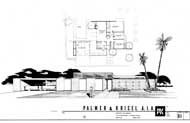William Krisel, Architect
Archival Program Information
For current Research Institute events, please see The Getty Event Calendar
For current Research Institute events, please see The Getty Event Calendar
Film Screening and Conversation
Tuesday, April 13, 2010
7:00–9:00 p.m. (note: new time)
Harold M. Williams Auditorium, The Getty Center
Reservations are full.
Admission is free. Reservations required.
Tuesday, April 13, 2010
7:00–9:00 p.m. (note: new time)
Harold M. Williams Auditorium, The Getty Center
Reservations are full.
Admission is free. Reservations required.

|
|
Throughout his extensive career in architecture, William Krisel has designed tens of thousands of homes. His visionary style virtually defined the geometric and spatial sensibility of modernist design in Southern California. William Krisel, Architect (2010), directed by Jake Gorst, explores Krisel's life and work, including his early experiences in China and his sustained career in truly innovative home design. This documentary blends a range of film sources, including historical footage of the architect at work, new interviews with scholars, and conversations with Krisel's colleagues, friends, and family.
In his post-and-beam style homes, Krisel integrated his distinctive geometric forms into the surrounding natural spaces of the California desert. During the 1950s, he built thousands of mass-produced tract homes in Palm Springs—and throughout Southern California—and thus played a key role in establishing the desert modernism of the area. In his early designs, Krisel worked closely with builder Robert Alexander to develop homes that were reasonably priced, undeniably stylish, and remarkably practical.
In his post-and-beam style homes, Krisel integrated his distinctive geometric forms into the surrounding natural spaces of the California desert. During the 1950s, he built thousands of mass-produced tract homes in Palm Springs—and throughout Southern California—and thus played a key role in establishing the desert modernism of the area. In his early designs, Krisel worked closely with builder Robert Alexander to develop homes that were reasonably priced, undeniably stylish, and remarkably practical.

|
|
During his incredibly prolific career, Krisel produced a great variety of buildings (including corporate office towers and massive hotels) throughout the United States, but his reputation as a pioneer of elegant yet affordable architecture was established through the distinctive private homes that he designed in the postwar years. His major achievement was to reconfigure the expectations of the average buyer of prefabricated housing in the 1950s. Krisel proved that modest midcentury homes did not have to be "cracker boxes" of unimaginative and claustrophobic design: he devised airy dwellings with massive windows opening onto the bright expanse of the surrounding landscape, featuring canted butterfly roofs encompassing the homes' interior and exterior spaces.
William Krisel's archive now resides at the Getty Research Institute. This screening will be followed by a conversation between Krisel and Wim de Wit, head of the Department of Architecture and Contemporary Art at the Getty Research Institute.
William Krisel's archive now resides at the Getty Research Institute. This screening will be followed by a conversation between Krisel and Wim de Wit, head of the Department of Architecture and Contemporary Art at the Getty Research Institute.